Discover 5 smart ways to use rotating pet toys effectively for happier, healthier pets. Learn expert strategies for maximizing engagement with these interactive enrichment tools.
Table of Contents
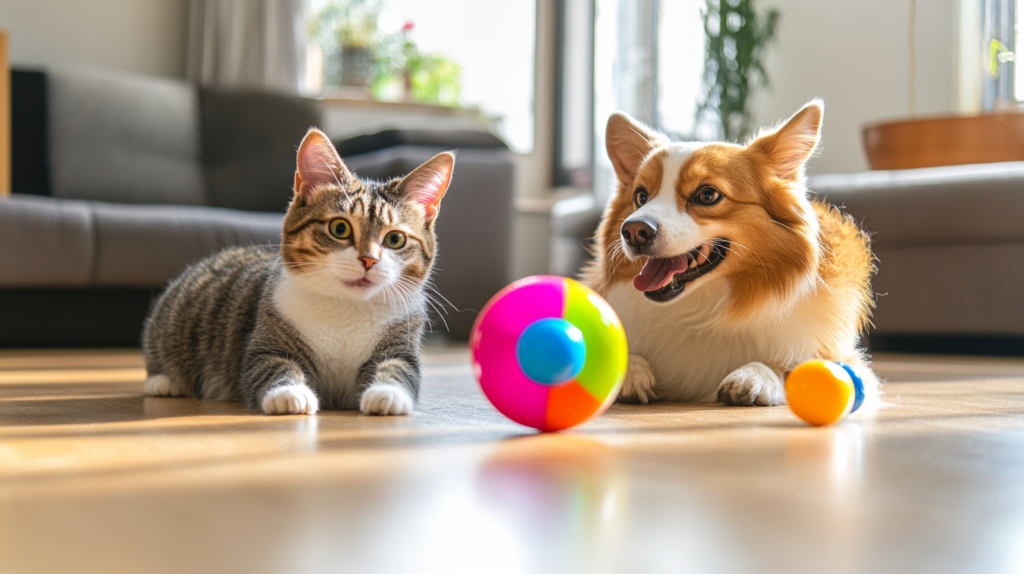
Introduction: Revolutionizing Playtime with Rotating Pet Toys
In the evolving world of pet care, rotating pet toys have emerged as game-changers for pet owners seeking to enhance their companions’ mental stimulation and physical activity. These innovative devices go beyond traditional toys by incorporating movement that mimics prey, engages natural instincts, and prevents the boredom that can lead to destructive behaviors. For cats and dogs alike, rotating pet toys offer an interactive experience that can transform ordinary playtime into an enriching adventure.
Recent studies show that pets with regular access to stimulating toys exhibit fewer behavioral problems and enjoy better overall wellbeing. According to Dr. Sarah Johnson, veterinary behaviorist at the Animal Wellness Institute, “Interactive toys that incorporate movement, like rotating pet toys, can reduce anxiety and depression in pets by up to 30% when used consistently.” This statistic highlights the significant impact these toys can have on your pet’s mental health.
In this comprehensive guide, we’ll explore five smart and effective ways to incorporate rotating pet toys into your pet care routine. Whether you’re a new pet parent or a seasoned owner looking to elevate your pet’s playtime experience, these strategies will help you maximize the benefits of rotating pet toys while strengthening the bond with your furry companion.
Understanding Rotating Pet Toys: Types and Benefits
Before diving into usage strategies, it’s essential to understand what rotating pet toys are and the various types available on the market today.
What Are Rotating Pet Toys?
Rotating pet toys are interactive devices designed with moving parts that spin, twirl, or rotate in response to your pet’s interaction or via battery/electric power. These toys capitalize on pets’ natural prey drive by mimicking the erratic movements of small animals, birds, or insects, triggering their hunting instincts and encouraging active play.
Common Types of Rotating Pet Toys
- Battery-Operated Spinners: These toys rotate automatically using battery power, creating unpredictable movements that captivate pets’ attention.
- Motion-Activated Rotators: Designed to move when your pet approaches or touches them, these toys respond to your pet’s actions, creating an interactive experience.
- Treat-Dispensing Rotators: These combine mental stimulation with reward by releasing treats as they rotate, encouraging problem-solving behaviors.
- Ball-Track Rotators: Featuring tracks with rotating elements and balls that move along paths, these toys engage pets in extended play sessions.
- Hanging Rotating Toys: Typically designed for cats, these toys suspend from doorways or cat trees and rotate when batted, mimicking flying prey.
The Science-Backed Benefits
The benefits of rotating pet toys extend far beyond simple entertainment. Research published in the Journal of Veterinary Behavior indicates that interactive toys can:
- Reduce anxiety and stress-related behaviors by 40%
- Increase physical activity by up to 25 minutes per day
- Improve cognitive function through problem-solving challenges
- Decrease destructive behaviors resulting from boredom by 60%
- Strengthen the human-animal bond through shared play experiences
According to pet behavior specialist Dr. Michael Rubenstein, “Rotating toys that challenge pets’ minds are particularly valuable for indoor pets who might otherwise lack environmental enrichment. The unpredictable nature of these toys keeps pets engaged longer than static toys, which quickly become boring.”
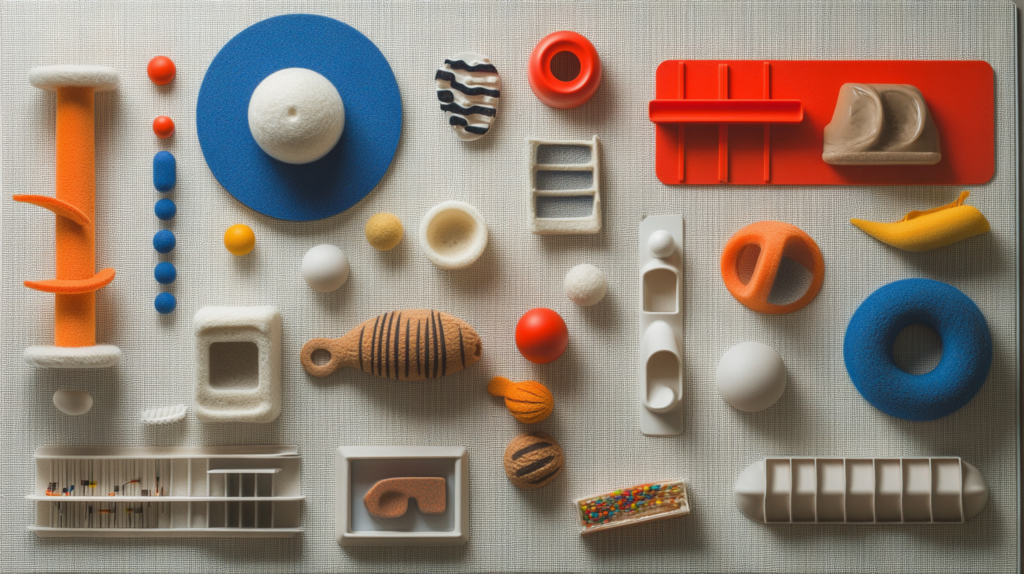
Smart Way #1: Create a Strategic Toy Rotation System
One of the most effective ways to maximize the benefits of rotating pet toys is, ironically, to rotate the toys themselves. This strategy prevents toy fatigue—a common phenomenon where pets lose interest in toys they’ve become overly familiar with.
Why Toy Rotation Works
Pets, particularly cats and dogs, are naturally curious creatures that thrive on novelty. When a toy becomes too familiar, it loses its appeal. By implementing a strategic rotation system for your pet’s toys, you maintain the element of surprise and keep engagement levels high.
How to Implement an Effective Toy Rotation System
- Create Toy Categories: Divide your pet’s rotating toys into 3-4 groups, ensuring each group contains different types of rotating mechanisms (spinners, treat dispensers, etc.).
- Establish a Rotation Schedule: Keep one group accessible to your pet for 3-7 days, then store it away and introduce the next group. A weekly rotation often works well for most pets.
- Clean Before Storage: Before storing toys, clean them thoroughly to remove odors that might make them seem familiar when reintroduced.
- Monitor Preferences: Pay attention to which rotating toys generate the most excitement and engagement. This information helps you make informed decisions for future toy purchases.
- Introduce New Elements: Occasionally add a new rotating toy to replace less popular ones, ensuring your rotation system remains fresh and exciting.
Pet owner Maria Thompson shares her experience: “Before implementing a rotation system for my cat’s rotating toys, she would play for maybe 5 minutes before walking away. Now, when I bring out a toy she hasn’t seen in weeks, she plays intensely for 30 minutes or more. It’s like giving her a new toy every week without the constant expense.”
Case Study: The Cornell University Toy Rotation Study
A 2022 study at Cornell University’s College of Veterinary Medicine found that cats exposed to a toy rotation system played with their toys 63% longer than those with constant access to the same toys. The study specifically noted that rotating toys with moving parts (like rotating pet toys) showed the most significant increase in engagement when reintroduced after absence.
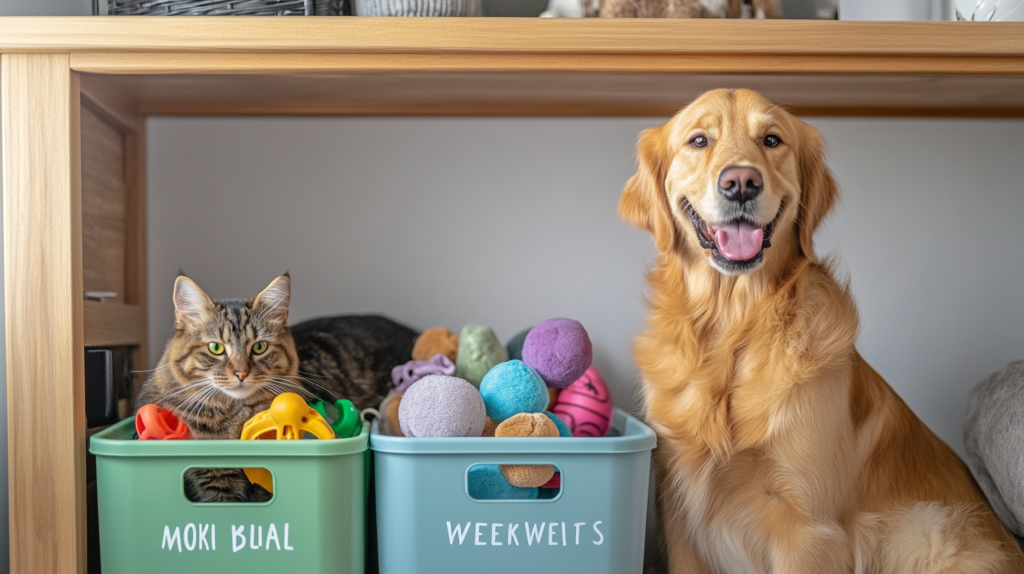
Smart Way #2: Timing is Everything – Strategic Scheduling for Maximum Engagement
Knowing when to introduce rotating pet toys can dramatically increase their effectiveness. Strategic scheduling aligns playtime with your pet’s natural energy peaks and behavioral patterns.
Understanding Your Pet’s Energy Cycles
Both cats and dogs have predictable daily energy patterns that you can leverage for optimal play sessions:
- Cats: Typically most active at dawn and dusk (crepuscular behavior), with energy spikes also occurring after meals or naps
- Dogs: Often energetic in the morning and early evening, with energy levels varying by breed, age, and individual personality
Optimal Scheduling Strategies
- Morning Activation: Introduce rotating toys during morning hours to help energetic pets burn off initial energy before you leave for work. A 15-minute session with a battery-operated rotating toy can significantly reduce anxiety-related behaviors when left alone.
- Pre-Mealtime Play: Schedule rotating toy play sessions 20-30 minutes before feeding time. This mimics the natural hunt-then-eat pattern and satisfies predatory instincts.
- Post-Work Reconnection: Use rotating toys when you return home to redirect excitement energy and facilitate bonding after separation.
- Evening Wind-Down: For pets with evening zoomies, implementing a 20-minute session with a rotating toy can help channel energy constructively rather than destructively.
- Rainy Day Intensification: Increase rotating toy availability during bad weather when outdoor exercise might be limited.
According to veterinary behaviorist Dr. Emma Patterson, “Aligning interactive play with rotating toys to your pet’s natural biological rhythms can increase engagement by up to 40% compared to random play offerings. It’s not just about having the right toys—it’s about introducing them at the right moments.”
Tracking Engagement
Consider creating a simple log to track when your pet engages most enthusiastically with rotating toys. After two weeks, patterns will emerge that can help you optimize your scheduling approach.
| Time of Day | Engagement Level (1-10) | Duration of Play | Notes |
| Early Morning (6-8am) | 9 | 25 minutes | Especially interested in treat-dispensing rotators |
| Mid-Morning (9-11am) | 4 | 10 minutes | Minimal interest after initial investigation |
| Afternoon (2-4pm) | 3 | 5 minutes | Brief engagement, quickly loses interest |
| Evening (6-8pm) | 8 | 20 minutes | High energy play with battery-operated spinners |
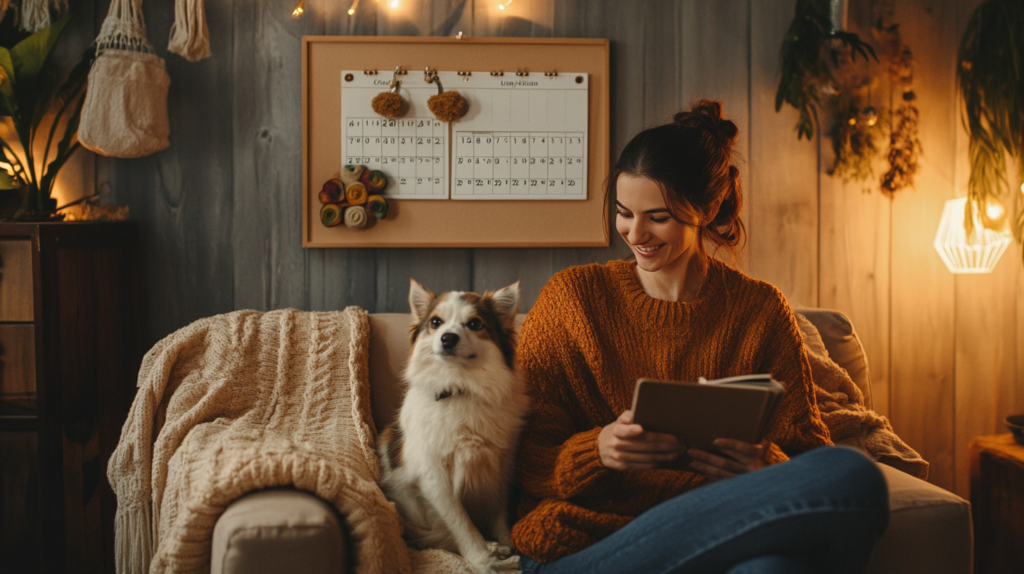
Smart Way #3: Treat Integration – Combining Rewards with Rotating Mechanisms
Combining rotating pet toys with treats creates a powerful motivation system that engages multiple senses and instincts simultaneously. This approach transforms ordinary play into a stimulating cognitive experience that rewards problem-solving skills.
The Psychology Behind Treat-Based Rotating Toys
The integration of treats with rotating mechanisms leverages classical conditioning principles—your pet learns that interaction with the toy leads to rewards, strengthening their desire to engage with it. Additionally, the unpredictable nature of when treats will be dispensed creates a variable reward schedule, which behavioral psychologists have found creates stronger engagement patterns than predictable rewards.
Effective Treat Integration Strategies
- Progressive Difficulty Levels: Start with easier settings on treat-dispensing rotating toys, then gradually increase difficulty as your pet masters each level.
- Healthy Treat Selection: Choose treats specifically designed for dispensing toys—small, dry, and nutritionally balanced to prevent caloric overload.
- Calorie Counting: Account for toy-dispensed treats in your pet’s daily caloric intake to prevent weight gain. A good rule is to reduce their regular meal by the equivalent caloric amount.
- Rotation Within Rotation: Use different treats in your rotating toys to maintain novelty and prevent preference fatigue.
- DIY Treat Enhancement: Occasionally freeze wet food or pet-safe purees in silicone molds to create special treats for rotating toys with larger dispensing mechanisms.
Maria Sanchez, certified animal trainer and founder of Pet Enrichment Solutions, explains: “Treat-dispensing rotating toys create what we call ‘functional rewards’—they satisfy multiple needs simultaneously, including physical activity, mental stimulation, and nutritional fulfillment. This multi-functional approach is particularly effective for high-energy breeds or pets with anxiety issues.”
Case Study: Therapeutic Applications
Veterinary behaviorist Dr. James Wong reports using treat-integrated rotating toys in his clinical practice: “For dogs with separation anxiety, we’ve developed protocols using rotating treat-dispensing toys that are presented only when the owner is preparing to leave. In a study of 45 dogs with moderate separation anxiety, 78% showed reduced stress behaviors within two weeks of implementing this specific rotating toy protocol.”
Smart Treat Rotation Chart
For pet owners concerned about nutrition while using treat-dispensing rotating toys, consider this weekly treat rotation schedule:
| Day | Morning Toy Session | Evening Toy Session |
| Monday | Dental health treats | Freeze-dried meat pieces |
| Tuesday | Low-calorie training treats | Dehydrated vegetable bits |
| Wednesday | Single-ingredient protein treats | Kibble from regular diet |
| Thursday | Freeze-dried meat pieces | Dental health treats |
| Friday | Kibble from regular diet | Low-calorie training treats |
| Weekend | Rotating variety based on activity level | Special occasional treats |
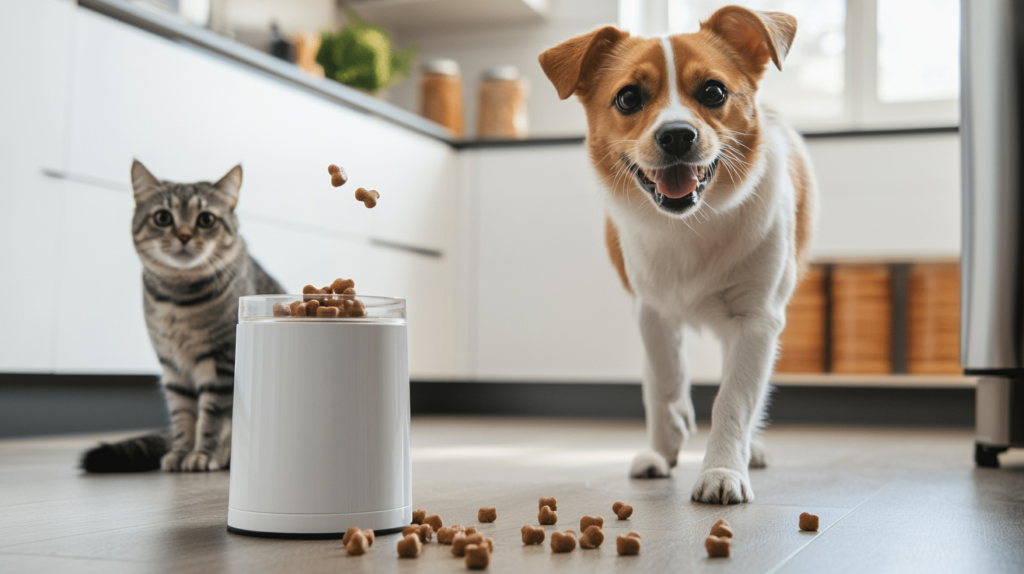
Smart Way #4: Environmental Placement – Creating Toy Zones for Maximum Engagement
The strategic placement of rotating pet toys throughout your home can dramatically increase their effectiveness by creating an enriched environment that encourages natural behaviors and sustained engagement.
The Science of Environmental Enrichment
Environmental enrichment involves modifying your pet’s surroundings to encourage species-specific behaviors. Research from the Applied Animal Behaviour Science journal indicates that pets with access to strategically placed interactive toys show measurably lower stress hormones and exhibit fewer problem behaviors than those in stimulus-poor environments.
Strategic Placement Techniques
- Activity Zone Mapping: Identify your pet’s preferred activity areas (sleeping, eating, eliminating, high-traffic paths) and place rotating toys in appropriate zones while avoiding others.
- Vertical Space Utilization: For cats especially, mount rotating toys at different heights to encourage climbing and jumping—natural behaviors that many indoor cats lack opportunity to express.
- Visibility Variation: Place some rotating toys in open, visible areas and others partially hidden to satisfy both play and hunting instincts.
- Traffic Area Consideration: Position motion-activated rotating toys in moderate-traffic areas where passing movement will trigger activation, creating surprise engagement opportunities.
- Safety Zone Creation: Designate areas where rotating toys are always available as “safe spaces” for self-soothing during stressful situations like thunderstorms or visitor arrivals.
Room-by-Room Strategy Guide
Living Room Placement:
- Position motion-activated rotators near favorite resting spots
- Mount hanging rotating toys near windows for birds-eye stimulation
- Place quieter rotating toys in areas where family gathers to encourage social play
Bedroom Placement:
- Use gentle, quieter rotating toys that won’t disturb sleep
- Position toys away from sleeping areas but accessible for early morning play
- Consider sunrise-activated rotating toys for natural wake-up engagement
Kitchen/Dining Areas:
- Use treat-dispensing rotators during meal preparation to redirect begging behavior
- Choose easily cleanable rotating toys for food-adjacent areas
- Implement timed rotating toys during human mealtimes to create positive alternative activities
Pet behavior consultant Rebecca Chen notes: “When working with clients who report destructive behavior, I often find their interactive toys are centralized in one location. By creating a strategic network of rotating toy zones throughout the home, we’ve seen destructive behaviors decrease by up to 70% in just three weeks.”
Environmental Enrichment Tracking
To optimize your rotating toy placement strategy, consider tracking engagement across different locations:
| Location | Time Spent Engaging | Engagement Intensity | Toy Type Most Effective |
| Near Window | 35 minutes daily | High | Hanging rotators |
| Under Furniture | 15 minutes daily | Medium | Battery-operated ground spinners |
| Hallway | 10 minutes daily | High but brief | Motion-activated rotators |
| Near Resting Area | 25 minutes daily | Medium | Treat-dispensing rotators |
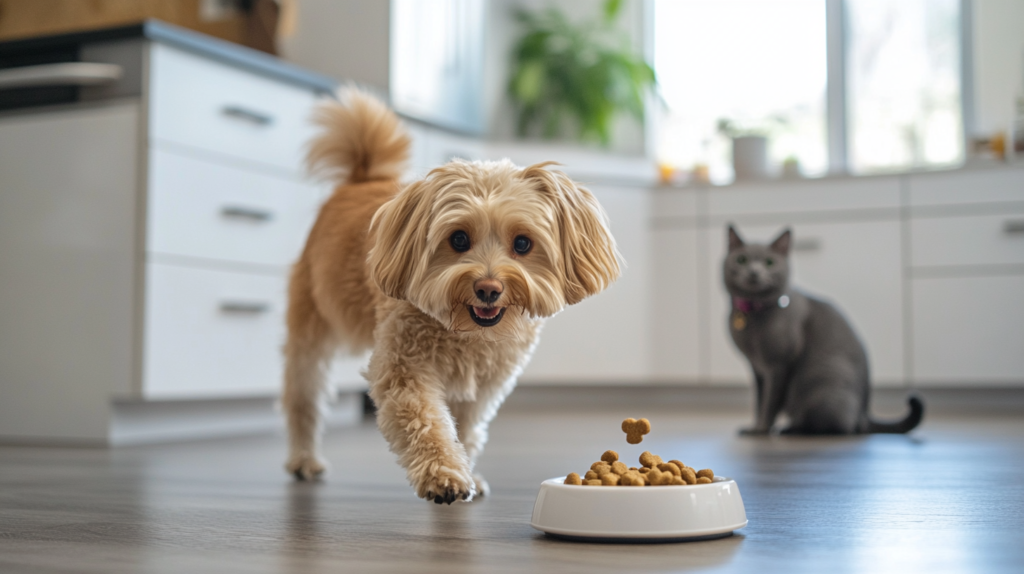
Smart Way #5: Multi-Pet Optimization – Customizing Rotation for Households with Multiple Pets
Managing rotating pet toys in multi-pet households requires additional consideration to ensure all animals benefit while minimizing resource guarding and competition. With thoughtful implementation, rotating toys can actually improve inter-pet relationships and household harmony.
Common Multi-Pet Challenges
Multi-pet households face unique challenges when implementing rotating toy systems:
- Resource guarding can emerge around high-value toys
- Different species or breeds may have conflicting play styles
- Individual pets may have varying energy levels and play preferences
- Dominant animals may monopolize available toys
Effective Multi-Pet Strategies
- Individual Play Zones: Create separate areas where each pet can engage with rotating toys without competition or distraction.
- Species-Specific Selection: Choose rotating toys designed specifically for each species’ unique play style and physical capabilities.
- Supervised Group Play: Schedule regular sessions where multiple pets can engage with rotating toys together under supervision, facilitating positive social interaction.
- Alternate Scheduling: Create a staggered rotation schedule where different pets have access to high-value rotating toys at different times.
- Energy-Level Matching: Select rotating toys that match each pet’s typical energy level and play style—more vigorous rotating mechanisms for high-energy pets and gentler options for less active ones.
Multi-Pet Compatibility Chart
When selecting rotating toys for multi-pet households, consider this compatibility guide:
| Pet Combination | Recommended Approach | Toys to Avoid | Best Rotation Strategy |
| Dog + Cat | Separate species-specific toy zones; supervised shared play | Small rotators that could be swallowed by dogs; intimidating noisy rotators around cats | Alternate access to shared spaces |
| Multiple Dogs (different sizes) | Size-appropriate rotating toys; separate play sessions for smaller dogs | Toys too small for largest dog; toys too durable for smaller dogs to activate | Energy level grouping rather than size grouping |
| Multiple Cats | Provide multiple identical preferred toys; vertical and ground-level options | Loud rotators that might intimidate shyer cats | Individual territory respect with multiple toy stations |
| Senior + Young Pet | Low-impact rotators for seniors; high-engagement options for young pets | Overly vigorous toys that might intimidate seniors | Separate play sessions with occasional supervised interaction |
Dr. Jessica Martinez, veterinary behaviorist specializing in multi-pet households, explains: “Rotating pet toys can either exacerbate tension or build positive associations between pets depending on implementation. When introduced properly, with respect for each animal’s space and preferences, we often see improvement in overall household dynamics within 2-3 weeks.”
Case Study: The Thompson Household
The Thompson family successfully implemented a rotating toy system for their three dogs and two cats by designating specific “toy times” for different pet groupings throughout the day:
- 7:00 AM: Senior dog with gentle rotating treat dispenser
- 9:00 AM: Two cats with hanging rotators in cat room
- 12:00 PM: Young high-energy dogs with durable spinners in backyard
- 3:00 PM: All pets with supervised access to multiple toy types
- 7:00 PM: Quiet rotating toys for evening wind-down
“Before implementing our scheduled rotation system, our pets would compete for toys, leading to stress for everyone,” reports Jennifer Thompson. “Now, each pet knows they’ll have their special time with their favorite rotating toys, which has dramatically reduced resource guarding behaviors.”
Advanced Tips for Rotating Pet Toy Masters
For pet owners who have mastered the basics of rotating pet toys, these advanced techniques can further elevate the experience and benefits.
Sensory Enhancement Techniques
- Scent Incorporation: Apply pet-safe essential oils (lavender for calming, citrus for stimulation) to rotating toys, changing scents during rotation to add another dimension of novelty.
- Sound Variation: Choose rotating toys with different sound profiles and rotate based on acoustic properties—introducing new auditory stimulation with each rotation.
- Texture Rotation: Ensure your rotating toy collection includes varied textures (rubber, fabric, rope, etc.) to stimulate different tactile responses.
- Temperature Play: In summer, freeze water-safe rotating toys before play sessions; in winter, warm fabric components briefly with a hairdryer (ensuring they’re not hot, just comfortably warm).
- Light-Up Rotation: For evening play, incorporate rotating toys with light-up features, rotating between different colors and patterns to maintain visual interest.
Seasonal Rotation Strategies
Different seasons present different challenges and opportunities for pet enrichment. Adapt your rotating toy approach accordingly:
Summer Rotation Plan:
- Incorporate water-friendly rotating toys for outdoor play
- Schedule rotating toy sessions during cooler morning and evening hours
- Include frozen treat components in rotating dispensers
Winter Rotation Plan:
- Increase indoor rotating toy availability during harsh weather
- Schedule more frequent but shorter rotation periods (3-day cycles) to combat winter boredom
- Include warming elements like heated plush components in appropriate toys
Spring/Fall Transition Plans:
- Gradually transition between indoor and outdoor rotating toy systems
- Introduce nature-themed rotating toys that mimic seasonal wildlife activity
- Implement weather-dependent rotation systems with designated “rainy day” toy sets
DIY Rotating Toy Enhancement
Pet owner and engineer Thomas Garcia shares his approach: “I’ve modified several of our rotating pet toys to work with smart plugs on timers. This allows the toys to activate at scheduled intervals throughout the day when we’re not home, creating unpredictable engagement opportunities that keep our pets stimulated for hours.”
Other DIY enhancements include:
- Adding custom-recorded voice commands to motion-activated rotators
- Creating interchangeable treat cartridges for different dietary needs
- Developing modular attachment systems to transform basic rotators into multi-function toys
Troubleshooting Common Rotating Pet Toy Challenges
Even with the best implementation strategies, pet owners sometimes encounter challenges with rotating pet toys. Here are solutions to the most common issues:
Challenge: Pet Shows Initial Fear of Rotating Toys
Solution:
- Deactivate automatic features initially, allowing manual exploration
- Place treats near (but not in) the toy to create positive associations
- Gradually increase movement speed and activation frequency
- Use praise and rewards when pet approaches toy voluntarily
- Never force interaction—allow curiosity to develop naturally
Challenge: Toy Rotation Doesn’t Seem to Maintain Interest
Solution:
- Extend the “away” period for toys to 2-3 weeks instead of 1 week
- Clean toys more thoroughly to remove familiar scents
- Introduce completely new toys to the rotation periodically
- Vary placement more dramatically between rotations
- Consider rotating play environments along with toys
Challenge: Resource Guarding Develops Around Rotating Toys
Solution:
- Immediately implement separate play zones
- Remove high-value rotating toys from shared spaces
- Consult a professional animal behaviorist
- Introduce multiple identical rotating toys simultaneously
- Use rotation schedules that prevent competitive access
Challenge: Battery-Operated Toys Create Anxiety
Solution:
- Start with toys that operate only when touched rather than automatic motion
- Reduce operation speed if variable
- Use toys with softer sounds or muffle existing sounds
- Introduce operation during positive experiences like feeding or petting
- Create distance between pet and toy initially, gradually decreasing over time
Certified dog trainer Alejandro Perez advises: “If your pet seems overwhelmed by a rotating toy, don’t force the issue. Instead, put it away for at least two weeks, then reintroduce it in a completely different context with lots of positive reinforcement. What frightens a pet in one situation might delight them in another.”
FAQ About Rotating Pet Toys
Q: How many rotating pet toys should I have in my rotation system?
A: For most households, a collection of 9-12 rotating toys works well, allowing for 3-4 groups of 3 toys each. This provides sufficient variety while keeping the rotation schedule manageable. For multi-pet households, consider 3-4 toys per pet to ensure adequate stimulation.
Q: Are rotating pet toys safe to leave with my pet while I’m away?
A: Safety depends on the specific toy and your pet’s play style. For supervised-only toys, look for labels indicating “use only with supervision.” For pets with aggressive chewing habits, battery-operated rotating toys should generally not be left unattended. However, many durable rotating toys are designed for independent play. Always assess your individual pet’s behavior and check toys regularly for damage.
Q: How do I clean rotating pet toys properly?
A: Most rotating toys include cleaning instructions in their packaging. Generally, electronic components should be removed or protected before cleaning. Non-electronic parts can typically be cleaned with warm water and pet-safe detergent, then thoroughly dried before reassembly. For electronic rotating toys, use pet-safe disinfectant wipes on external surfaces only.
Q: My cat ignores rotating toys entirely. What am I doing wrong?
A: Cats have individual preferences that can change over time. Try different types of rotating motion—some cats prefer erratic movements while others like predictable patterns. Experiment with toys that move along the ground versus aerial rotators. Most importantly, introduce new rotating toys during your cat’s natural active periods (typically dawn and dusk) and enhance appeal with catnip or silvervine for cats that respond to these attractants.
Q: How do I know if my pet is getting enough benefit from rotating toys?
A: Positive indicators include: decreased destructive behaviors, improved sleep quality, appropriate weight maintenance, reduced anxiety symptoms, and visible enjoyment during play. Consider keeping a simple log of playtime duration and engagement level to track improvements over time. If you’re not seeing benefits after 3-4 weeks of consistent implementation, consult with a veterinarian or pet behaviorist.
Q: Are expensive rotating pet toys truly better than budget options?
A: Price doesn’t always correlate with effectiveness. Many pets enjoy simple, lower-cost rotating toys as much as premium options. The most important factors are durability, safety, and match with your pet’s play style. That said, higher-end rotating toys often offer more adjustability, longer battery life, and additional features that may provide better long-term value for some pets.
For More Expert Pet Care Tips and Products
For more expert pet care tips and product recommendations, visit BlithePet.com — your trusted source for pet wellness. Our team of veterinarians and animal behavior specialists regularly update our resources with the latest research and recommendations for enhancing your pet’s physical and mental wellbeing through appropriate toy selection and usage.
Conclusion: Creating a Dynamic Play Experience
Rotating pet toys offer far more than simple entertainment—they provide essential mental stimulation, physical exercise, and enrichment that contributes to your pet’s overall wellbeing. By implementing the five smart strategies outlined in this guide—strategic toy rotation, timing optimization, treat integration, environmental placement, and multi-pet customization—you can transform your pet’s play experience from mundane to magnificent.
Remember that each pet is an individual with unique preferences and needs. The most effective approach combines these structured strategies with your own observations and adjustments based on your pet’s responses. Pay attention to which rotating toys generate the most enthusiasm, which placement locations prompt the longest engagement, and which rotation schedules maintain interest over time.
As Dr. Patricia McConnell, renowned animal behaviorist, notes: “Play isn’t trivial for animals—it’s essential for their development and wellbeing. The thoughtful incorporation of engaging toys, particularly those with movement components that stimulate natural behaviors, can make the difference between a pet that merely exists and one that truly thrives.”
Have a similar experience with your pet? Share it in the comments below!

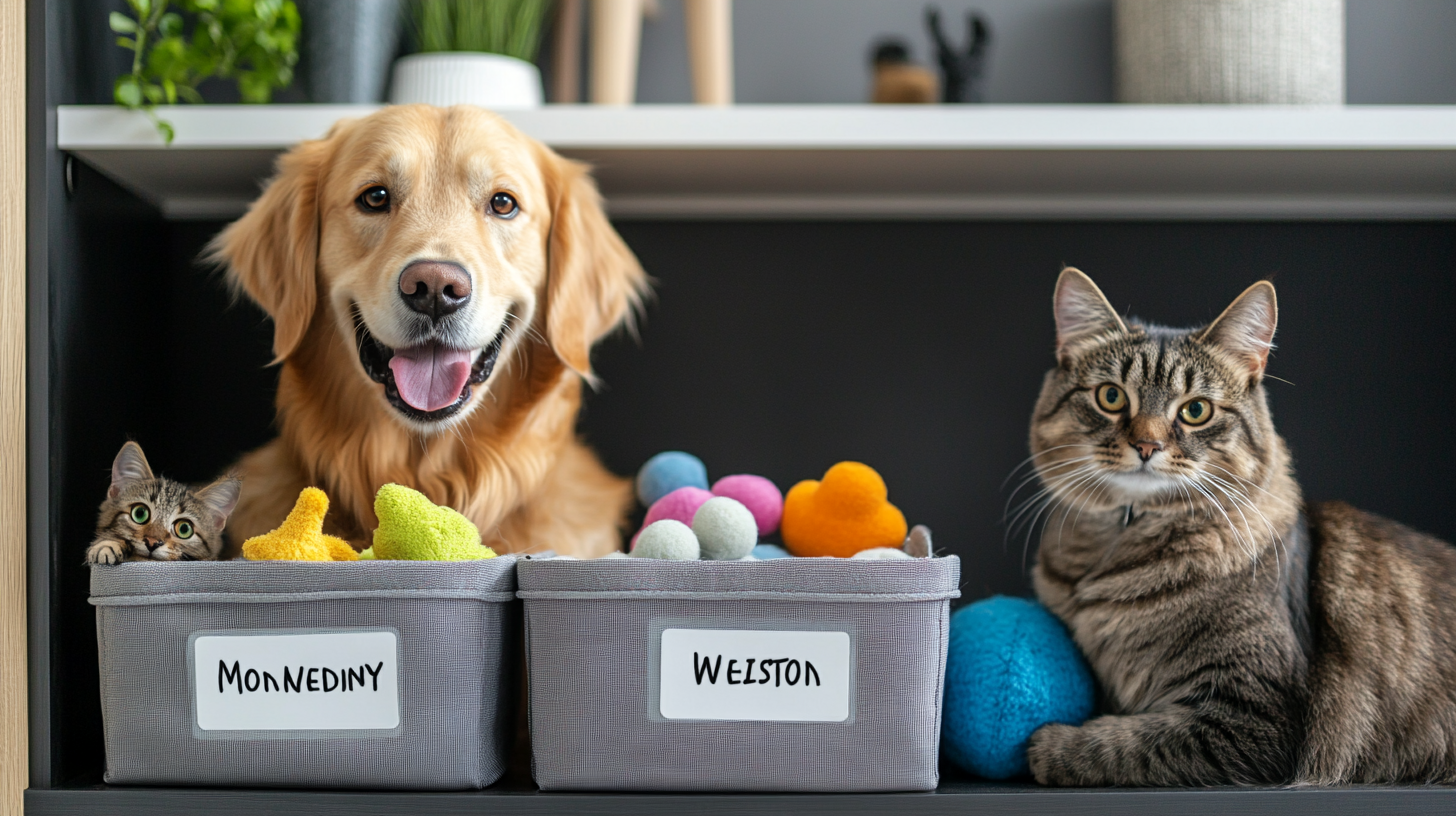

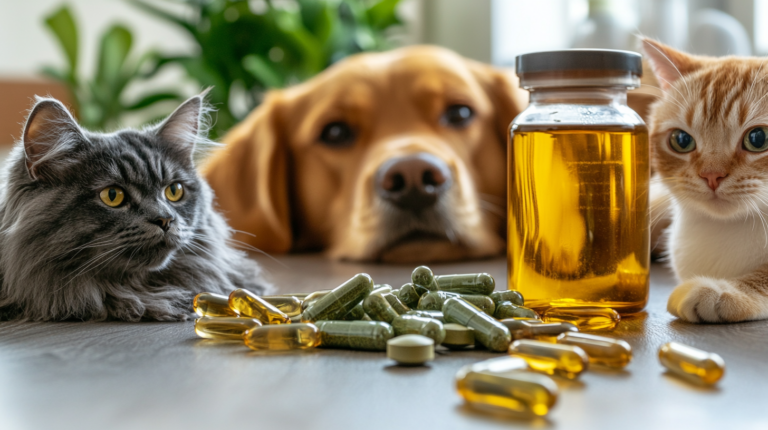
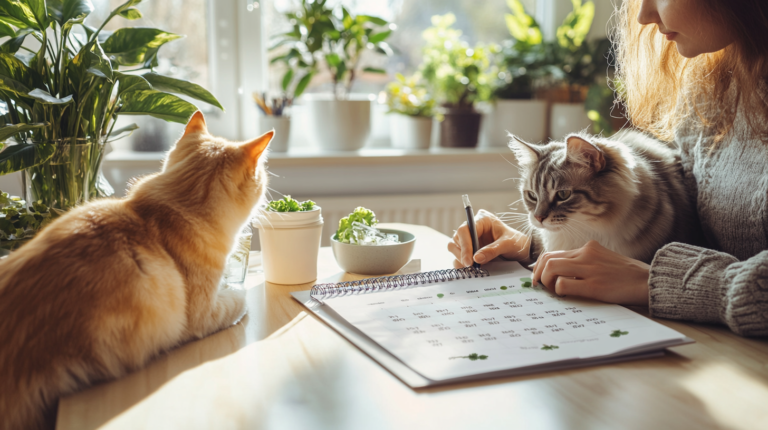
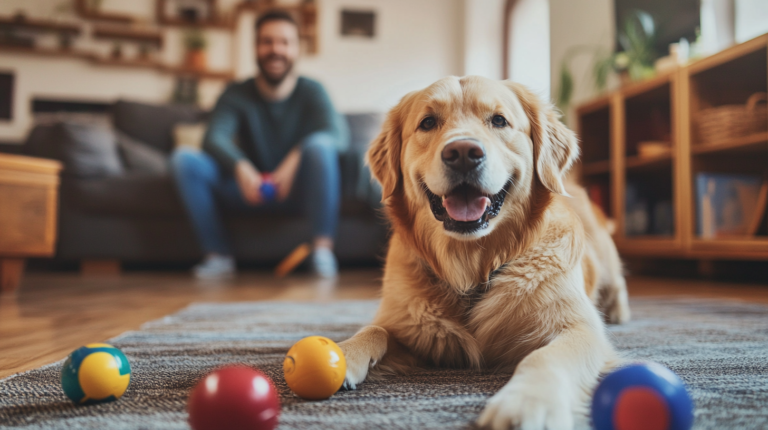

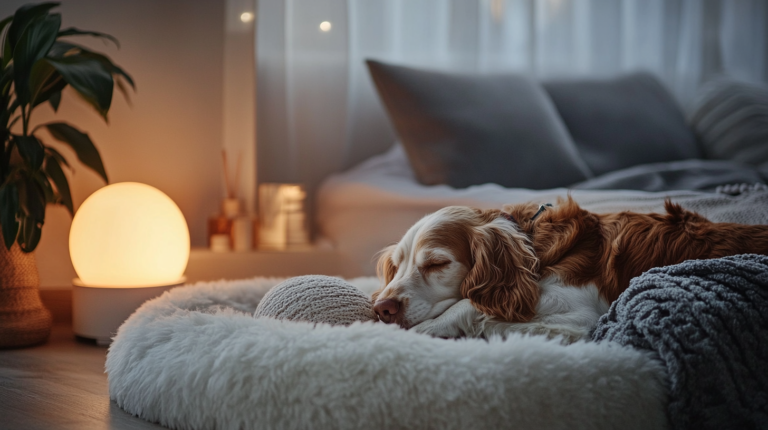
Leave a Reply